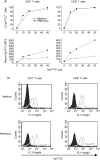Haptoglobin directly affects T cells and suppresses T helper cell type 2 cytokine release
- PMID: 12562322
- PMCID: PMC1782886
- DOI: 10.1046/j.1365-2567.2003.01569.x
Haptoglobin directly affects T cells and suppresses T helper cell type 2 cytokine release
Abstract
T helper cell type 1 (Th1) and type 2 (Th2) immune responses are characterized by a different pattern of cytokine expression following T-cell activation. Alterations of the ratio of Th1 to Th2 cells are important determinants of susceptibility to viral and parasitic infections, allergies, anti-tumour responses, and autoimmunity. In this work we bring new evidence for an effect of haptoglobin (Hp), a positive acute-phase protein, on T-lymphocyte functions. We show that Hp specifically interacts with both resting and activated CD4+ and CD8+ T cells. This specific binding results in a strong suppression of induced T-cell proliferation. In addition, Hp exhibits a strong in vitro inhibitory effect on Th2 cytokine release, while the production of interferon-gamma (IFN-gamma) and interleukin-2 (IL-2) is only slightly inhibited at high Hp doses. As a result, the presence of Hp promotes Th1 activation over Th2 activation in vivo as evidenced in Hp-deficient mice. Anti-CD3 monoclonal antibody injection indeed resulted in predominant IL-4 production in Hp-/- mice, in contrast to predominant IFN-gamma production in Hp+/+ mice. We conclude that Hp plays a modulating role on the Th1/Th2 balance by promoting a dominant Th1 cellular response. This points to a role of acute-phase proteins in balancing immune responses.
Figures




Similar articles
-
Haptoglobin and the Th1/Th2 balance: hints from in vitro and in vivo studies.Redox Rep. 2001;6(6):369-71. doi: 10.1179/135100001101536481. Redox Rep. 2001. PMID: 11865978
-
T helper 1/T helper 2 cytokine imbalance in respiratory syncytial virus infection is associated with increased endogenous plasma cortisol.Pediatrics. 2006 May;117(5):e878-86. doi: 10.1542/peds.2005-2119. Epub 2006 Apr 17. Pediatrics. 2006. PMID: 16618789
-
Limiting dilution analysis of CD4 T-cell cytokine production in mice administered native versus polymerized ovalbumin: directed induction of T-helper type-1-like activation.Immunology. 1996 Jan;87(1):119-26. Immunology. 1996. PMID: 8666423 Free PMC article.
-
The Th1/Th2 balance in autoimmunity.Curr Opin Immunol. 1995 Dec;7(6):793-8. doi: 10.1016/0952-7915(95)80050-6. Curr Opin Immunol. 1995. PMID: 8679122 Review.
-
Vaccine strategies: targeting helper T cell responses.Ann N Y Acad Sci. 1995 May 31;754:126-37. doi: 10.1111/j.1749-6632.1995.tb44445.x. Ann N Y Acad Sci. 1995. PMID: 7625646 Review.
Cited by
-
Haptoglobin Phenotypes and Susceptibility to Schistosoma Parasites Infection in Central Sudan.Mediterr J Hematol Infect Dis. 2017 Jul 1;9(1):e2017042. doi: 10.4084/MJHID.2017.042. eCollection 2017. Mediterr J Hematol Infect Dis. 2017. PMID: 28698785 Free PMC article.
-
The Different Paths That Lead to Hypotonic Hyponatremia, and a Safe Approach to Treatment.J Clin Med. 2024 Dec 27;14(1):92. doi: 10.3390/jcm14010092. J Clin Med. 2024. PMID: 39797178 Free PMC article. Review.
-
Haptoglobin and sickle cell polymorphisms and risk of active trachoma in Gambian children.PLoS One. 2010 Jun 11;5(6):e11075. doi: 10.1371/journal.pone.0011075. PLoS One. 2010. PMID: 20552021 Free PMC article.
-
Haptoglobin enhances cardiac transplant rejection.Circ Res. 2015 May 8;116(10):1670-9. doi: 10.1161/CIRCRESAHA.116.305406. Epub 2015 Mar 23. Circ Res. 2015. PMID: 25801896 Free PMC article.
-
Metabolomic Profiling in Neuromyelitis Optica Spectrum Disorder Biomarker Discovery.Metabolites. 2020 Sep 18;10(9):374. doi: 10.3390/metabo10090374. Metabolites. 2020. PMID: 32961928 Free PMC article. Review.
References
-
- Abbas AK, Murphy KM, Sher A. Functional diversity of helper T lymphocytes. Nature. 1996;383:787–93. - PubMed
-
- Arredouani M, Ceuppens JL. Haptoglobin – a new link between innate and adaptive immunity. Curr Trends Immunol. 2003 in press.
-
- Langlois MR, Delanghe JR. Biological and clinical significance of haptoglobin polymorphism in humans. Clin Chem. 1996;42:1589–600. - PubMed
-
- Baseler MW, Burrell R. Purification of haptoglobin and its effects on lymphocyte and alveolar macrophage responses. Inflammation. 1983;7:387–400. - PubMed
Publication types
MeSH terms
Substances
LinkOut - more resources
Full Text Sources
Other Literature Sources
Molecular Biology Databases
Research Materials
Miscellaneous

